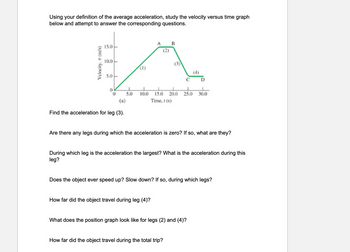Question
thumb_up100%
Solve all parts

Transcribed Image Text:Using your definition of the average acceleration, study the velocity versus time graph
below and attempt to answer the corresponding questions.
Velocity, v (m/s)
15.0
10.0
5.0
0 5.0
(a)
Find the acceleration for leg (3).
(1)
10.0
(2)
B
How far did the object travel during leg (4)?
(3)
CD
15.0 20.0 25.0
Time, ! (s)
Are there any legs during which the acceleration is zero? If so, what are they?
During which leg is the acceleration the largest? What is the acceleration during this
leg?
How far did the object travel during the total trip?
30.0
Does the object ever speed up? Slow down? If so, during which legs?
What does the position graph look like for legs (2) and (4)?
Expert Solution
This question has been solved!
Explore an expertly crafted, step-by-step solution for a thorough understanding of key concepts.
This is a popular solution
Trending nowThis is a popular solution!
Step by stepSolved in 4 steps with 3 images

Knowledge Booster
Similar questions
- What are the components of the vector 35.6m [E 56º S] ?arrow_forwardDetermine the resultant when the following three vectors are added together: Vector #1: 2N, 40oN of E Vector #2: 1N, 50oS of W Vector #3: 1.5N, 40oN of Warrow_forward. Calculate the area of the parallelogram whose two adjacent sides are formed by the vectors. A = 31 + 4k B = 23+k.arrow_forward
arrow_back_ios
arrow_forward_ios